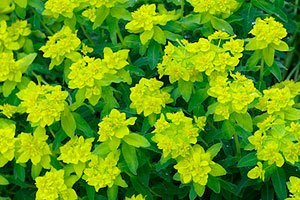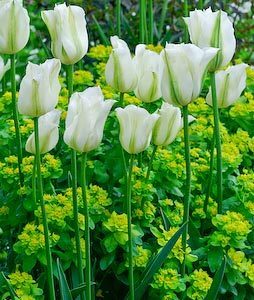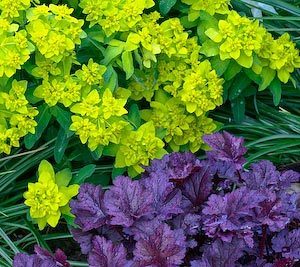Cushion Spurge or Euphorbia polychroma is one of my favorite spring perennials. It blooms so long that we enjoy its bright chrome yellow flowers for weeks. To get technical, the flowers are actually bracts or modified leaves, which is why they last so long.
The plant’s common name comes from its cushion-like, dome-shaped growth habit.
Euphorbia polychroma stars in spring garden

The bright chrome yellow flowers of cushion spurge
Photo: © Y.Cunnington
This is a great spring perennial, which is quite drought-tolerant and cold hardy for USDA Zones 4 to 8.
If happy, it will self-seed, so it can become a good groundcover plant.
We often dig up seedlings and either move them elsewhere in the garden, or pot them up and grow them on for the following year.
Some people consider this plant a garden thug because of its self-seeding tendency, but I find it’s easy to control, either by weeding out unwanted seedlings or clipping the plant back by a third after it has flowered.

Euphorbia polychroma with ‘Spring Green’ tulips
Photo: © Y.Cunnington
In any case, it is not one of those truly invasive plants that spreads by roots and becomes impossible to get rid of.
I have planted Euphorbia polychroma in full sun at the edges of garden beds and paired it with ‘Spring Green’ tulips and purple-leaved Heuchera, as shown here and below.
How to grow
Light: In zones 4 to 5, it does very well in full sun.
But in hotter, more southern regions, you’re better off to plant it in part shade – a spot with morning sun and afternoon shade is ideal.
Soil: This perennial does well in average, well-drained soil, and grows 12 to 15 inches tall and about two feet wide.

Cushion spurge with Heuchera ‘Plum Pudding’
Photo: © Y.Cunnington
Cutting back: Cut the plants back by about a third after flowering is finished. Doing this will also curb self-seeding.
This helps plants stay compact and prevents them from falling apart in the center, which mature plants have a tendency to do in mid-summer.
Just be careful to wear gloves when you’re handling the plant – it has white sap that can irritate your skin.
More companions
for Euphorbia polychroma
- Spring bulbs (grape hyacinths, ‘Spring Green’ tulips)
- Bugleweed (Ajuga)
- Candytuft (Iberis sempervirens)
- Coral Bells (Heuchera cultivars)
- Iris (Bearded or Siberian)
- Rock Cress (Arabis caucasica)
- Pinks (Dianthus)
A note about the name
I always call this spurge Euphorbia polychroma, but apparently E. epithymoides is correct. According to my favorite perennial expert Allan Armitage:
“The proper botanical name of this species is constantly in doubt. E. polychroma, named by an Austrain, Anton Josef Kerner in 1875, was superseded by E. epithymoides, given by Linnaeus, in 1770. Normally the first name takes precedence, and thus E. epithymoides should be the correct name. However, that name had been given to another species. Because of this confusion, cushion spurge will be listed by both names for many years to come; choose the one you like and stay with it.” (Herbaceous Perennial Plants, 1989)
Of course, most gardeners ignore botanical names, and go with cushion spurge.




